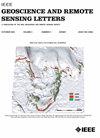一种改进的无人机SAR成像地图漂移算法
IF 4
3区 地球科学
Q2 ENGINEERING, ELECTRICAL & ELECTRONIC
引用次数: 16
摘要
无人机合成孔径雷达(SAR)通常对轨迹偏差敏感,轨迹偏差会导致记录数据产生严重的运动误差。由于无人机体积小,难以携带高精度惯性导航系统。因此,为了获得精确的SAR图像,提出了相位梯度自动聚焦(PGA)法和地图漂移(MD)算法等基于接收信号补偿运动误差的自动聚焦算法,但这些算法大多针对距离不变的运动误差和大量的突出散射体。在这篇文章中,提出了一种改进的MD算法来补偿距离变化的运动误差。在这种情况下,为了解决均匀场景或不存在突出散射体造成的异常点,采用随机样本一致性(RANSAC)算法来减轻异常点的影响,实现不同情况下的鲁棒性能。最后,通过实际SAR数据验证了该方法的有效性。本文章由计算机程序翻译,如有差异,请以英文原文为准。
An Improved Map-Drift Algorithm for Unmanned Aerial Vehicle SAR Imaging
Unmanned aerial vehicle (UAV) synthetic aperture radar (SAR) is usually sensitive to trajectory deviations that cause severe motion error in the recorded data. Because of the small size of the UAV, it is difficult to carry a high-accuracy inertial navigation system. Therefore, in order to obtain a precise SAR imagery, autofocus algorithms, such as phase gradient autofocus (PGA) method and map-drift (MD) algorithm, were proposed to compensate the motion error based on the received signal, but most of them worked on range-invariant motion error and abundant prominent scatterers. In this letter, an improved MD algorithm is proposed to compensate the range-variant motion error compared to the existed MD algorithm. In this context, in order to solve the outliers caused by homogeneous scenes or absent prominent scatterers, a random sample consensus (RANSAC) algorithm is employed to mitigate the influence resulting from the outliers, realizing robust performance for different cases. Finally, real SAR data are applied to demonstrate the effectiveness of the proposed method.
求助全文
通过发布文献求助,成功后即可免费获取论文全文。
去求助
来源期刊

IEEE Geoscience and Remote Sensing Letters
工程技术-地球化学与地球物理
CiteScore
7.60
自引率
12.50%
发文量
1113
审稿时长
3.4 months
期刊介绍:
IEEE Geoscience and Remote Sensing Letters (GRSL) is a monthly publication for short papers (maximum length 5 pages) addressing new ideas and formative concepts in remote sensing as well as important new and timely results and concepts. Papers should relate to the theory, concepts and techniques of science and engineering as applied to sensing the earth, oceans, atmosphere, and space, and the processing, interpretation, and dissemination of this information. The technical content of papers must be both new and significant. Experimental data must be complete and include sufficient description of experimental apparatus, methods, and relevant experimental conditions. GRSL encourages the incorporation of "extended objects" or "multimedia" such as animations to enhance the shorter papers.
 求助内容:
求助内容: 应助结果提醒方式:
应助结果提醒方式:


